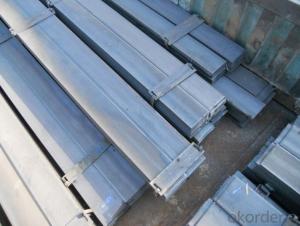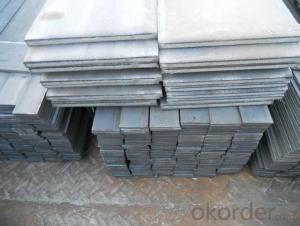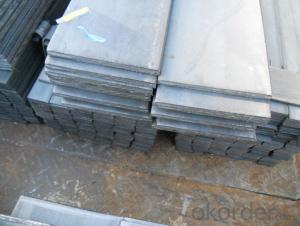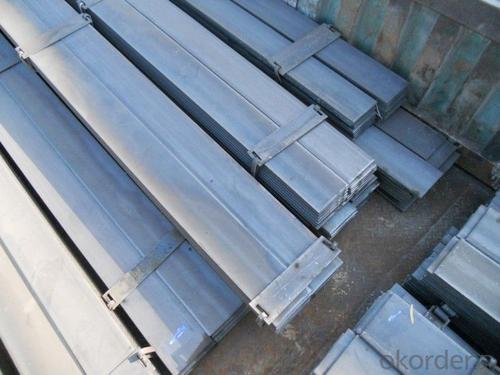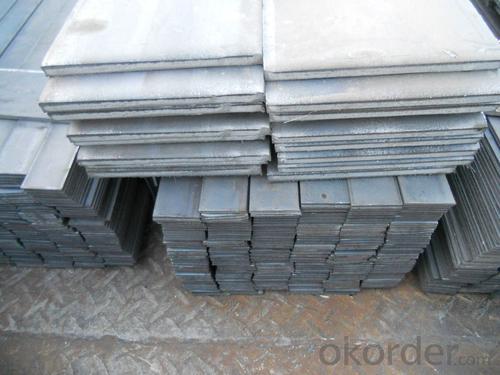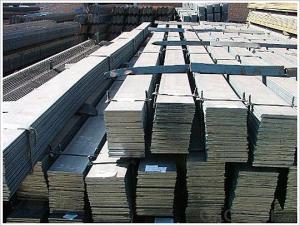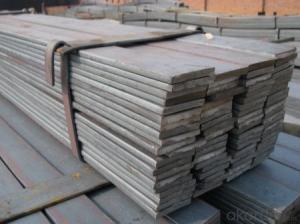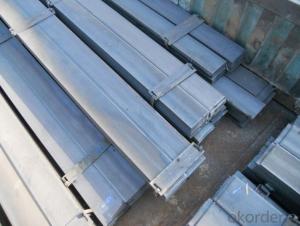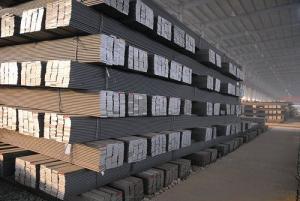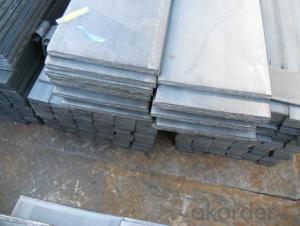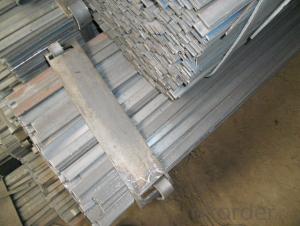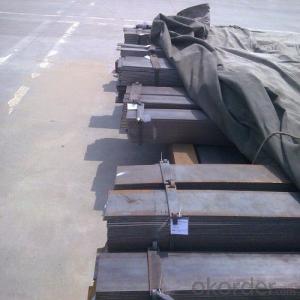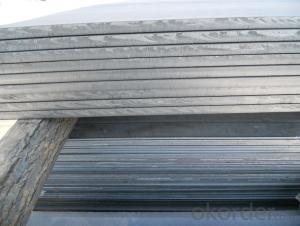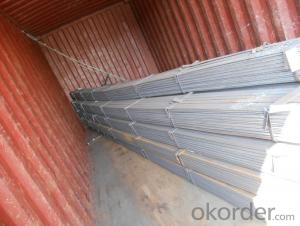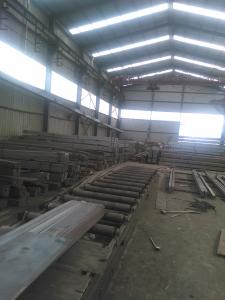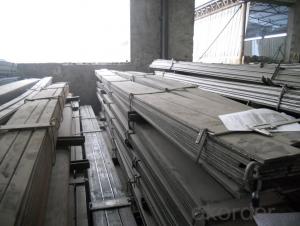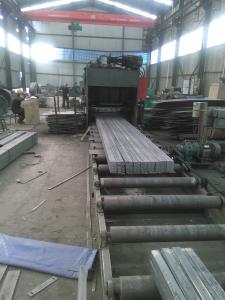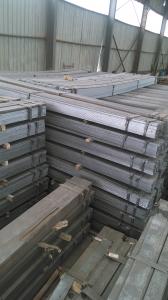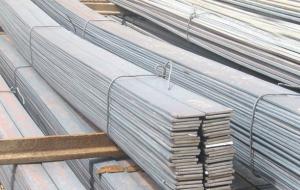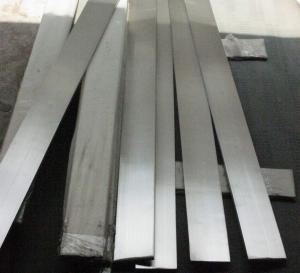Seel Flat Bars with Material Grade Q235/SS400
- Loading Port:
- Tianjin
- Payment Terms:
- TT OR LC
- Min Order Qty:
- 25 m.t.
- Supply Capability:
- 10000 m.t./month
OKorder Service Pledge
OKorder Financial Service
You Might Also Like
Product Description:
OKorder is offering high quality Flat Bar at great prices with worldwide shipping. Our supplier is a world-class manufacturer of steel, with our products utilized the world over. OKorder annually supplies products to European, North American and Asian markets. We provide quotations within 24 hours of receiving an inquiry and guarantee competitive prices.
Product Applications:
Flat Bars are ideal for structural applications and are widely used in the construction of buildings and bridges, and the manufacturing, petrochemical, and transportation industries.
Product Advantages:
OKorder's Flats Barare durable, strong, and resist corrosion.
Main Product Features:
· Premium quality
· Prompt delivery & seaworthy packing (30 days after receiving deposit)
· Corrosion resistance
· Can be recycled and reused
· Mill test certification
· Professional Service
· Competitive pricing
Product Specifications:
Manufacture: Hot Rolled
Grade: Q195 – 235 ;SS400
Certificates: ISO, SGS, BV, CIQ
Length: 6m – 12m, as per customer request
Packaging: Export packing, nude packing, bundled
Chemical composition of Q235
Alloy No | Grade | Element(%) | ||||
C
| Mn
| S
| P
| Si
| ||
Q235
|
B
|
0.12—0.20 |
0.3—0.7 |
≤0.045 |
≤0.045
|
≤0.3
|
Physical properties of Q235
Alloy No | Grade | Yielding strength point(Mpa) | Tensile strength (Mpa) | Elongation after fracture(%) | ||||||
Thickness (mm) | Thickness (mm) | |||||||||
≤16 | >16--40 | >40--60 | >60--100 | ≤16 | >16--40 | >40--60 | >60--100 | |||
≥ | ≥ | |||||||||
Q235 |
B |
235 |
225 |
215 |
205 |
375--500 |
26 |
25 |
24 |
23 |
FAQ:
Q1: How soon can we receive the product after purchase?
A1: Within three days of placing an order, we will begin production. The specific shipping date is dependent upon international and government factors, but is typically 7 to 10 workdays.
Q2: How do we guarantee the quality of our products?
A2: We have established an advanced quality management system which conducts strict quality tests at every step, from raw materials to the final product.
Q3: The products are invoicing on theoritical weight or on actual weight basis ?
A3: We can do it in both manners, according to buyers' requirement.
Q4: What is the normal tolerance of your steel products ?
A4: Normally 7%-9%, but we can also produce the goods according to the customers' requests.
Images:
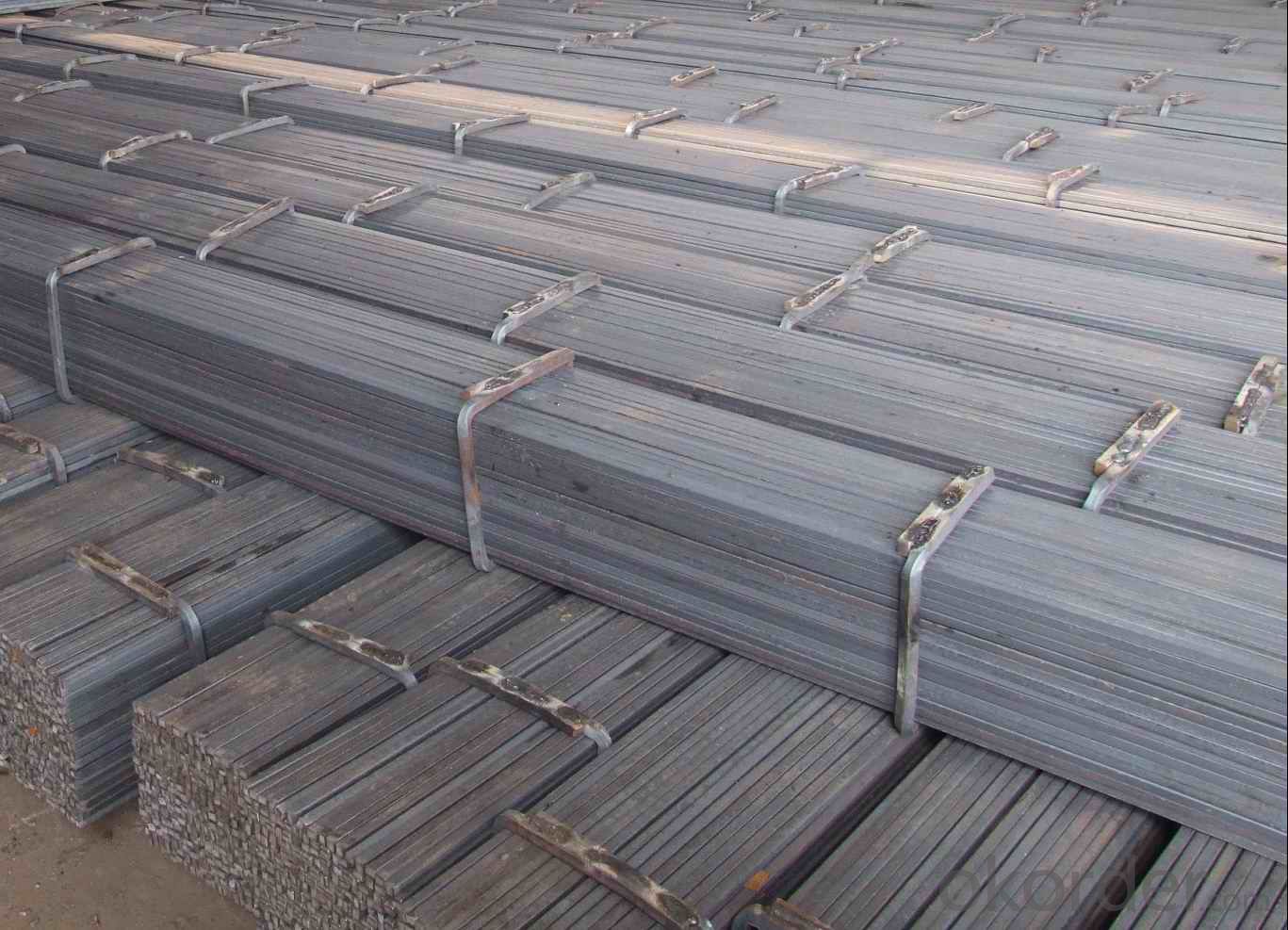
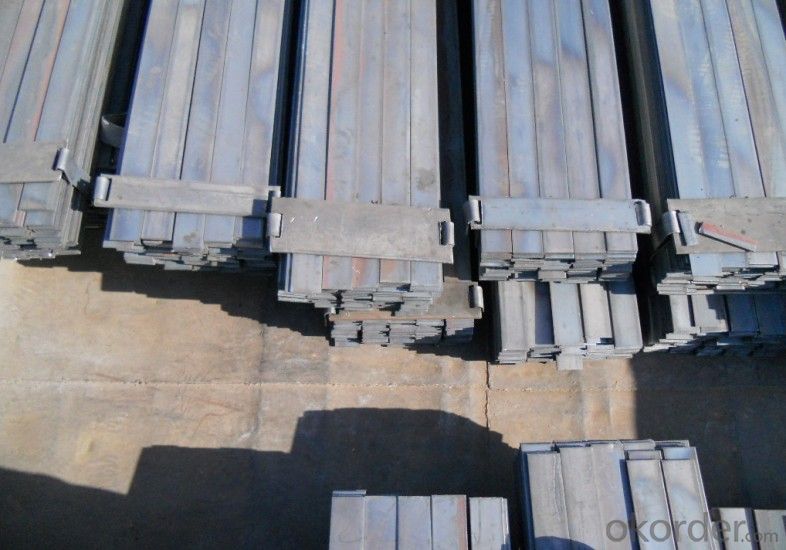
- Q: What are the different methods of surface texturing for steel flat bars?
- There are several different methods of surface texturing for steel flat bars. These methods can be used to impart various textures and patterns onto the surface of the bars, providing aesthetic appeal, improved grip, or enhanced functionality. Some common methods of surface texturing for steel flat bars include: 1. Shot blasting: This method involves propelling small metal or abrasive particles at high velocity onto the surface of the steel flat bars. The impact of these particles creates a textured surface by removing any existing scale, mill scale, or rust, leaving behind a clean and roughened finish. 2. Sanding or grinding: These methods involve using abrasive tools, such as sandpaper or grinding wheels, to manually remove material from the surface of the steel flat bars. This can create a textured finish with patterns or grooves, depending on the technique used. 3. Knurling: Knurling is a process where a pattern of ridges or grooves is rolled or pressed onto the surface of the steel flat bars. This method is often used to improve grip and prevent slipping, making it suitable for applications where a non-slip surface is required. 4. Acid etching: Acid etching involves using chemical solutions to selectively remove a thin layer of the steel's surface, creating a textured pattern. This method allows for precise control over the texture and can produce intricate designs or logos on the steel flat bars. 5. Roller embossing: In this method, the steel flat bars are passed through a set of rollers with engraved patterns. As the bars pass through the rollers, the pattern is pressed onto the surface, creating a textured finish. Roller embossing can be used to create various designs and textures, providing an aesthetic appeal to the steel flat bars. 6. Laser texturing: Laser technology can be used to create precise and intricate patterns on the surface of steel flat bars. By using a laser beam to remove material from the surface, a textured finish can be achieved with high accuracy and repeatability. This method is often used for decorative purposes or for specialized applications where precise texture control is required. Each of these methods offers its unique advantages and can be chosen based on the desired texture, application requirements, and cost-effectiveness. The selection of the appropriate surface texturing method for steel flat bars depends on factors such as the intended use, desired appearance, functionality, and budget constraints.
- Q: What are the properties of steel flat bars?
- Steel flat bars, known for their strength and versatility, are rectangular bars made of steel. These bars possess several properties that make them suitable for a variety of uses. To begin with, steel flat bars exhibit excellent tensile strength, enabling them to withstand high levels of tension without breaking or deforming. This characteristic renders them ideal for structural applications, such as building construction and engineering projects, where durability and strength are paramount. Another notable attribute of steel flat bars is their resistance to corrosion. To enhance this resistance, steel is typically alloyed with elements like chromium or nickel. Consequently, steel flat bars are suitable for outdoor applications or environments exposed to moisture, chemicals, or extreme temperatures. Furthermore, steel flat bars possess good weldability, allowing them to be easily joined or welded using different techniques. This feature facilitates the fabrication of complex structures or the reinforcement of existing ones, making steel flat bars a popular choice in the manufacturing and construction industries. In addition, steel flat bars have a high melting point, making them appropriate for applications involving exposure to elevated temperatures. They can endure heat without compromising their structural integrity, making them suitable for use in furnaces, ovens, or industrial machinery. Lastly, steel flat bars can be effortlessly machined, cut, or shaped to meet specific requirements. This quality enables customization and versatility in various applications, including the production of machinery parts, brackets, frames, and supports. In summary, the properties of steel flat bars, including their strength, corrosion resistance, weldability, high melting point, and machinability, make them a reliable and versatile choice for a wide range of applications in multiple industries.
- Q: Are steel flat bars commonly used in the energy sector?
- Yes, steel flat bars are commonly used in the energy sector. They are widely utilized in various applications such as construction of power plants, transmission towers, and pipelines due to their strength, durability, and versatility.
- Q: Are steel flat bars suitable for high-temperature applications?
- No, steel flat bars are generally not suitable for high-temperature applications. Steel has a relatively low melting point compared to other high-temperature materials such as stainless steel or refractory metals. When exposed to high temperatures, steel flat bars can experience dimensional changes, loss of strength, and even deformation or failure. For high-temperature applications, it is recommended to use materials specifically designed and engineered to withstand elevated temperatures, ensuring safety and performance.
- Q: Can steel flat bars be used for manufacturing medical devices?
- Yes, steel flat bars can be used for manufacturing medical devices. Steel is a commonly used material in the medical industry due to its strength, durability, and resistance to corrosion. Steel flat bars can be shaped and machined into various components and structures required for medical devices, making them suitable for use in manufacturing such devices.
- Q: Can steel flat bars be used for making construction equipment or vehicles?
- Yes, steel flat bars can be used for making construction equipment or vehicles. Steel flat bars are commonly used in the manufacturing of heavy-duty machinery and vehicles due to their high strength, durability, and resistance to wear and tear. They provide structural support and can be shaped or welded to meet specific design requirements.
- Q: Can steel flat bars be used for manufacturing appliances?
- Yes, steel flat bars can be used for manufacturing appliances as they provide strength, durability, and versatility in various applications.
- Q: Can steel flat bars be used in the construction of railways?
- One can utilize steel flat bars in the construction of railways. Steel is widely employed in railway construction owing to its robustness, longevity, and resistance to deterioration. Steel flat bars serve as crucial support structures like track sleepers or ties, providing stability and reinforcement to the railway tracks. These bars are specifically designed to endure heavy loads and offer a solid foundation for the tracks, guaranteeing smooth and secure rail transportation. Additionally, steel flat bars can also be utilized in the building of railway bridges, platforms, and other infrastructure that necessitate sturdy and dependable materials. In general, steel flat bars are a suitable option for railway construction due to their exceptional strength and ability to withstand the demanding conditions of railway operations.
- Q: How do steel flat bars compare to other types of metal flat bars?
- Steel flat bars have several advantages over other types of metal flat bars. Firstly, steel is known for its strength and durability, making it a reliable choice for various applications. Steel flat bars can withstand heavy loads and are less likely to bend or break under pressure compared to other metals. Additionally, steel flat bars offer excellent corrosion resistance, especially when compared to metals like aluminum or copper. This makes them suitable for outdoor or marine environments where exposure to moisture or saltwater is common. Another advantage of steel flat bars is their versatility. They can be easily welded, formed, or machined to meet specific requirements. Steel can also be heat-treated to enhance its properties, such as hardness or toughness. Furthermore, steel flat bars are readily available in a wide range of sizes and thicknesses, making them suitable for various construction, manufacturing, and industrial applications. They are commonly used in structural support, frames, brackets, and machinery components. However, it is important to note that steel flat bars may be heavier than other metals, such as aluminum. This can be a consideration when weight is a concern, especially in industries like aerospace or automotive. Overall, steel flat bars offer a combination of strength, durability, corrosion resistance, and versatility that makes them a popular choice in many industries.
- Q: Galvanized steel flat welding occurs after the material itself crack.
- Thermal cracking: most of the material being welded is alloy, and the solidification of the alloy starts from the beginning to the end, which is carried out in a certain range, which is the basic cause of the thermal crack.
Send your message to us
Seel Flat Bars with Material Grade Q235/SS400
- Loading Port:
- Tianjin
- Payment Terms:
- TT OR LC
- Min Order Qty:
- 25 m.t.
- Supply Capability:
- 10000 m.t./month
OKorder Service Pledge
OKorder Financial Service
Similar products
Hot products
Hot Searches
Related keywords
